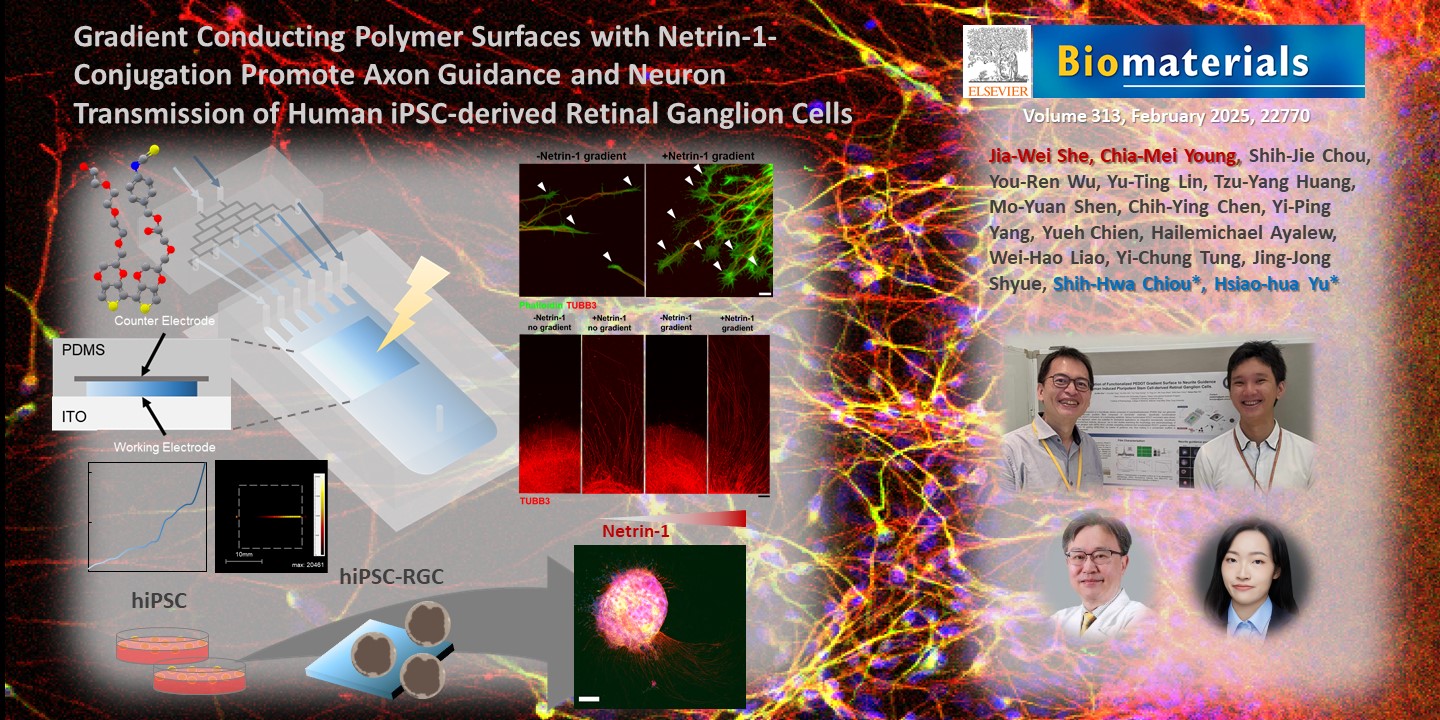Institute of Chemistry, Academia Sinica – Research
導電高分子梯度界面結合 Netrin-1 以促進人類 iPSC 分化之視網膜神經節細胞的軸突引導
Gradient conducting polymer surfaces with netrin-1-conjugation promote axon guidance and neuron transmission of human iPSC-derived retinal ganglion cells
Biomaterials 2025, 313, 22770.
Jia-Wei She, Chia-Mei Young, Shih-Jie Chou, You-Ren Wu, Yu-Ting Lin, Tzu-Yang Huang, Mo-Yuan Shen, Chih-Ying Chen, Yi-Ping Yang, Yueh Chien, Hailemichael Ayalew, Wei-Hao Liao, Yi-Chung Tung, Jing-Jong Shyue, Shih-Hwa Chiou*, Hsiao-hua Yu *

人類誘導多能幹細胞(hiPSCs)在再生醫學領域已取得許多重大進展。然而,將hiPSCs順利融入再生目標組織仍然是個挑戰,特別是視網膜神經節細胞(RGC)相關的修復。在本研究中,我們提出了一種為視網膜再生細胞提供方向性引導的可行方法。首先,我們開發了一種基於導電高分子的梯度界面構建技術,該技術可應用於各種帶官能基的乙烯二氧噻吩(EDOT)單體。利用PDMS製作樹枝狀微流道和特別設計的電化學腔體,生成的濃度梯度流可通過循環伏安法轉化為具官能基密度梯度的PEDOT薄膜。我們利用螢光標記、飛行時間二次離子質譜(TOF-SIMS)和X射線光電子能譜(XPS)分析了成功製備的梯度流和材料表面特性。實驗結果表明,種植於PEDOT上的hiPSC-RGCs在神經突觸生長、軸突引導及神經電生理皆有所改善。我們的新型PEDOT介面可能作為hiPSC技術的一種有潛力的組織工程支架,用於視網膜退化性疾病及視神經病變中RGC的功能性修復。
Major advances have been made in utilizing human-induced pluripotent stem cells (hiPSCs) for regenerative medicine. Nevertheless, the delivery and integration of hiPSCs into target tissues remain significant challenges, particularly in the context of retinal ganglion cell (RGC) restoration. In this study, we introduce a promising avenue for providing directional guidance to regenerated cells in the retina. First, we developed a technique for construction of gradient interfaces based on functionalized conductive polymers, which could be applied with various functionalized ehthylenedioxythiophene (EDOT) monomers. Using a tree-shaped channel encapsulated with a thin PDMS and a specially designed electrochemical chamber, gradient flow generation could be converted into a functionalized-PEDOT gradient film by cyclic voltammetry. The characteristics of the successfully fabricated gradient flow and surface were analyzed using fluorescent labels, time of flight secondary ion mass spectrometry (TOF-SIMS), and X-ray photoelectron spectroscopy (XPS). Remarkably, hiPSC-RGCs seeded on PEDOT exhibited improvements in neurite outgrowth, axon guidance and neuronal electrophysiology measurements. These results suggest that our novel gradient PEDOT may be used with hiPSC-based technologies as a potential biomedical engineering scaffold for functional restoration of RGCs in retinal degenerative diseases and optic neuropathies.
